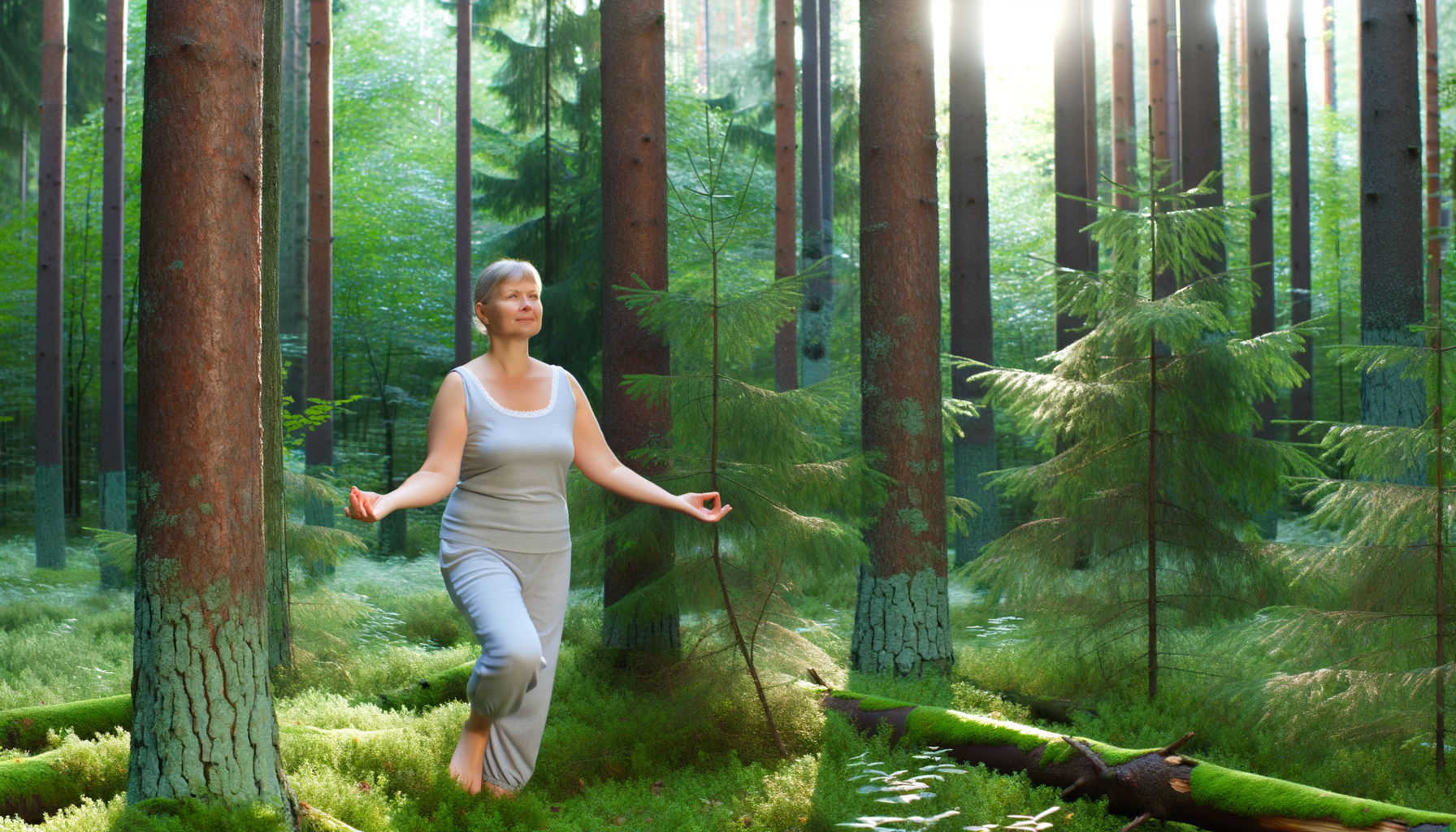The concept of Shinrin Yoku
Shinrin Yoku, or forest bathing, is a Japanese term that translates to “taking in the forest atmosphere.” It is a practice that involves immersing oneself in the natural environment, particularly forests, to enhance health, wellness, and happiness. The concept is based on the understanding that spending time in nature, and specifically in forests, can have profound effects on our physical and mental health.
Historical and cultural origins
The practice of Shinrin Yoku has its roots in Japan, where it was developed in the 1980s as a response to the high stress levels associated with fast-paced urban life. It draws on ancient Shinto and Buddhist practices that emphasize the importance of nature in human life. The cultural belief in the healing power of nature has been an integral part of Japanese history and is now being embraced by other cultures around the world.
Relevance in the modern world
In today’s fast-paced and technology-driven society, people are increasingly disconnected from the natural world. This disconnection has been linked to a host of health issues, including stress, anxiety, and depression. Forest bathing offers a way to counteract these effects by encouraging people to slow down, unplug from technology, and reconnect with nature. The practice has gained global recognition for its ability to reduce stress, improve mood, and increase overall well-being.
The pandemic’s impact on outdoor activities
The COVID-19 pandemic has led to a renewed interest in outdoor activities, as people seek safe ways to exercise and find solace during times of social distancing. Forest bathing has emerged as a popular activity, providing a respite from the confines of home and the stress of the pandemic. The natural isolation of forests makes them ideal spaces for maintaining social distance while engaging in a health-promoting activity. As a result, many have turned to the healing power of nature to cope with the challenges brought on by the pandemic.
Personal Journeys Back to Nature
Rediscovering Nature as an Adult
For many adults, the hustle of daily life often leads to a disconnection from the natural world. Yet, there comes a moment when the call of the wild becomes irresistible A profound pull back to nature. This rekindled connection to nature is not an exception; many individuals feel a similar awakening, a desire to reconnect with the earth and its calming, restorative powers.
The Transformative Power of Nature on Wellbeing
The impact of nature on our wellbeing is both profound and well-documented. Immersion in natural settings has been shown to reduce stress, enhance mood, and improve overall mental health. For adults who have strayed from their youthful outdoor adventures, returning to nature can be transformative. It offers a sanctuary from the noise of civilization and a space to breathe, reflect, and heal.
Menopause and the Draw of the Outdoors
Menopause is a significant life transition for women, often accompanied by a host of physical and emotional challenges. The outdoors, with its fresh air and tranquility, can be particularly alluring during this time. The draw of the outdoors for menopausal women is multifaceted: it provides a respite from hot flashes, an opportunity for gentle exercise to maintain bone density, and a community of others experiencing similar life changes. Nature becomes a natural companion and healer during this pivotal phase.
Nature’s Role in Alleviating Menopause Symptoms
Nature’s healing role is especially evident in the relief it provides from menopause symptoms. Oftentimes, women discover that their symptoms, such as hot flashes and mood swings, were alleviated through her time spent outdoors. Forest bathing, in particular, with its emphasis on mindfulness and connection to the environment, can offer significant relief. The practice encourages a meditative state, allowing women to manage stress and find balance amidst hormonal changes. Moreover, the supportive community that often forms during group forest bathing sessions provides a space for sharing and healing, further easing the menopause journey.
In conclusion, the personal journey back to nature is a powerful one, offering adults a chance to rediscover the magic of the outdoors. For women experiencing menopause, the draw of the outdoors can be particularly strong, providing a natural remedy for symptoms and a supportive community. As we continue to explore the benefits of forest bathing and other nature-based practices, we uncover the timeless truth that nature is a profound healer, ready to embrace us at any stage of life.
Forest Bathing as a Healing Modality
Incorporating Forest Bathing into Holistic Practices
Forest bathing, or Shinrin Yoku, has emerged as a significant component of holistic health practices, offering a natural and accessible means to enhance physical and mental well-being. Holistic health practitioners recognize the interconnectedness of the body, mind, and spirit, and forest bathing aligns perfectly with this philosophy. By integrating forest bathing into their repertoire, practitioners provide clients with an opportunity to experience the therapeutic effects of nature, which can complement and enhance other treatment modalities such as Reiki, meditation, and cognitive-behavioral therapy.
The Structure of a Forest Bathing Session
A typical forest bathing session is structured to facilitate a deep connection with nature through a series of guided, mindful activities. These sessions, usually lasting from two to four hours, are designed to be slow-paced and accessible to individuals of all fitness levels. Participants are encouraged to engage their senses fully, immerse themselves in the forest atmosphere, and practice mindful breathing and walking. The guide facilitates the experience by offering invitations to interact with the environment, such as touching the bark of a tree or observing the intricate patterns of leaves, which helps to anchor the participants in the present moment.
Unique Activities and Techniques Used
Forest bathing guides employ a variety of unique activities and techniques to deepen the participants’ connection with nature. These may include:
- Guided visualization exercises to enhance sensory perception
- Gentle stretching or yoga to connect with the body and surroundings
- Tree hugging to experience the energy and stability of trees
- Foraging for edible plants to engage the sense of taste
- Creating natural art or mandalas as a form of expression and mindfulness
The Role of Meditation and Mindfulness
Meditation and mindfulness are central to the practice of forest bathing, serving as the foundation for the deep, restorative connection with nature. Participants are guided into meditative states that encourage a heightened awareness of their surroundings, allowing them to let go of stress and enter a state of relaxation. Mindfulness practices during forest bathing, such as focused breathing and attentive observation, help to quiet the mind and reduce the incessant chatter that often dominates our thoughts. This mindful presence is what allows for the therapeutic benefits of forest bathing to manifest, leading to reduced stress, improved mood, and a greater sense of peace and well-being.
The Science Behind Forest Bathing
Research on the benefits of forest bathing
Forest bathing, or Shinrin-yoku, has been a subject of scientific interest since its inception in Japan during the 1980s. Numerous studies have explored the health benefits associated with spending time in forested environments. One of the key findings is the positive impact on stress reduction, as forest environments have been shown to lower cortisol levels, a hormone associated with stress. Additionally, research indicates that forest bathing can lead to reductions in blood pressure and improvements in heart rate variability, suggesting a more relaxed state of being.
Understanding the physiological effects
The physiological effects of forest bathing are profound and multifaceted. The inhalation of phytoncides, which are natural oils produced by trees, has been linked to increased natural killer (NK) cell activity. NK cells play a crucial role in the body’s defense against viruses and tumors, suggesting that forest environments may enhance immune system function. Furthermore, exposure to forest environments has been associated with increased parasympathetic nervous activity, which promotes bodily rest and digestion, and decreased sympathetic nervous activity, which is responsible for the ‘fight or flight’ response.
The psychological impact of nature immersion
Psychologically, forest bathing has been found to contribute to emotional well-being and mental health. Time spent in forests can lead to improvements in mood, reduced feelings of anxiety and depression, and an overall sense of rejuvenation. The natural setting provides a respite from the overstimulation of urban environments, allowing individuals to reconnect with nature and experience a sense of tranquility and mindfulness.
Case studies and anecdotal evidence
Anecdotal evidence and case studies further support the scientific findings on the benefits of forest bathing. Individuals who participate in forest therapy programs often report a sense of peace, improved concentration, and a deeper connection to the natural world. Health practitioners who prescribe forest bathing as part of holistic treatment plans have observed improvements in patients with chronic stress, burnout, and various mental health conditions. These personal accounts align with the growing body of research advocating for the inclusion of nature-based therapies in health and wellness practices.
In conclusion, the science behind forest bathing underscores its potential as a therapeutic practice for enhancing physical and mental health. As society grapples with the challenges of modern living, forest bathing offers a natural and accessible means to promote healing and well-being.

From unhappy, dry, and sandpaper to silky, smooth and feeling good. That’s Cleo. Cleo is a 100% natural labial balm to moisture and soothe “your other lips”. Cleo is chemical-free, water-free, pH optimized and helps maintain and restore your delicate labial skin’s natural flora. Ideal for daily use or as needed. Get the most silky, lovable lips ever.
Community and Connection Through Nature
Creating Spaces for Healing in Nature
The concept of healing in nature is not new, but its formal integration into therapeutic practices has gained momentum in recent years. Spaces for healing in nature are intentionally designed environments that facilitate a connection with the natural world, offering a sanctuary from the stressors of daily life. These spaces are often characterized by elements such as tranquil gardens, forest trails, and water features, which collectively contribute to a sense of peace and restoration. The design of these spaces is guided by the understanding that the environment plays a crucial role in the healing process, offering a backdrop for reflection, meditation, and rejuvenation.
The Importance of Mental Space and Connection
Mental space, the psychological equivalent of physical breathing room, is essential for individuals to process emotions and experiences. Nature inherently provides this mental space, allowing for introspection and the opportunity to disconnect from the digital and urban clutter that often dominates our lives. The connection fostered in these natural settings goes beyond the individual, extending to the community and the environment itself. This bond is particularly poignant for those experiencing life transitions, such as menopause, where the need for understanding and support is heightened.
Support Groups and Community Building Outdoors
Support groups that meet in natural settings can offer unique benefits compared to their indoor counterparts. The act of sharing experiences and challenges while immersed in nature can create a more open and honest dialogue among participants. The outdoors serves as a neutral ground, free from the confines and formalities of traditional meeting spaces. Community building in these settings is enhanced by the shared experience of the natural world, fostering a sense of unity and belonging that can be therapeutic in itself.
Nature’s Role During Social Distancing and Lockdowns
The COVID-19 pandemic has underscored the importance of nature for mental and physical well-being, especially during times of social distancing and lockdowns. With indoor gatherings restricted, nature has become a refuge where people can safely connect with others. The practice of forest bathing, or Shinrin Yoku, has seen a surge in popularity as individuals seek out the therapeutic benefits of being in nature. The pandemic has highlighted the vital role that natural spaces play in maintaining community connections and supporting mental health during challenging times.
In conclusion, the creation of healing spaces in nature, the provision of mental space and connection, the formation of support groups, and the utilization of nature during social distancing are all critical components in fostering community and connection through nature. As we navigate the complexities of life transitions such as menopause, the embrace of the natural world offers a powerful tool for healing and shared experience.

Bette 100% All-Natural Relaxing Lavender Body Lotion.
Chemical-Free
Your relaxing night time body moisturizer to leave the day’s stress behind. Decompress and wish your body good night with the calming scent of lavender.
Looking Forward: The Future of Forest Bathing
Expanding the Practice of Forest Bathing
As awareness of the benefits of forest bathing grows, so does the practice itself. The concept of Shinrin Yoku, which translates to “taking in the forest atmosphere,” is gaining traction beyond its Japanese roots. This expansion is multifaceted, encompassing public health initiatives, eco-tourism, and personal wellness practices. With the increasing prevalence of mental health issues and the stress of modern life, forest bathing offers a natural and accessible remedy that appeals to a wide audience. The practice is poised to become a cornerstone in the movement towards preventative healthcare and holistic well-being.
Challenges and Opportunities for Forest Bathing Guides
The future holds both challenges and opportunities. As the demand for guided forest therapy sessions increases, guides face the challenge of maintaining the integrity and quality of the experience. Balancing the need for certification and insurance with the desire to keep forest bathing accessible to all is a delicate task. However, this growth also presents opportunities for guides to innovate and create diverse offerings, such as incorporating elements of local culture or other therapeutic practices into their sessions. Guides have the chance to become leaders in a burgeoning field, shaping the practice and its impact on society.
The Potential for Broader Impact
The potential for forest bathing to make a broader impact is significant. With research supporting its health benefits, forest bathing has the potential to influence public health policies and urban planning. Cities might integrate green spaces designed specifically for forest therapy, contributing to the well-being of their inhabitants. Additionally, forest bathing could play a role in environmental conservation efforts, as the practice emphasizes the importance of preserving natural spaces for human health. By fostering a deeper connection between people and nature, forest bathing can encourage a more sustainable and mindful way of living.
Personal Aspirations and Goals in Forest Bathing
Individuals engaged in forest bathing, whether as guides or participants, often develop personal aspirations and goals related to the practice. For some, it is about deepening their connection with nature and continuing to explore its healing properties. Others may focus on sharing their knowledge and experiences, aspiring to teach and empower more people to embrace forest bathing. Many guides aim to create inclusive and supportive communities around forest bathing, ensuring that the practice remains accessible and beneficial for diverse populations. Ultimately, the personal journeys in forest bathing are as varied as the forests themselves, each with its unique story and contribution to the collective growth of this healing modality.



















